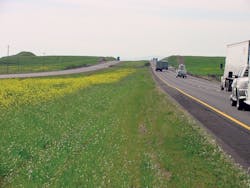Caltrans maintains safer roadsides
The California Department of Transportation (Caltrans) manages more than 50,000 miles of California's highway and freeway roadsides. What started with maintaining footpaths and wagon routes more than 100 years ago has evolved into the overseeing of a sophisticated roadway system that serves the transportation needs of more than 30 million residents.
Caltrans is divided into 12 geographic districts, and vegetation management plays an important role in each. District 4, which encompasses the Bay Area, is subdivided into four regions, and Bill Nantt is the landscape specialist for the East Bay and Delta regions, as well as a portion of Sacramento County that runs into the Sacramento River Delta.
Targeting tough woody species
The Bay Area’s roadsides are home to a variety of problem woody-plant species, including Scotch broom, poison oak, acacia and tree-of-heaven. When Nantt was transferred to the Bay Area, he brought experience successfully using aminopyralid-based Milestone VM Plus specialty herbicide (Milestone VM Plus is being rebranded as Capstone specialty herbicide in 2012) for woody-plant removal along roadsides in California’s Central Valley.
On larger plants like tree-of-heaven, Nantt uses a basal bark application of the specialty herbicide mixed with a quart of crop oil concentrate per gallon of spray solution. “We’ll also use that rate and method on smaller woody species while dormant,” Nantt said. “On species like poison oak, brooms and acacia growing in clumps 6 ft or less, we apply [the herbicide] at 2% mixed with 1% crop oil concentrate per gallon during the growing season.”
Control rates of these species have been excellent at 80% to 85%; however, Nantt pointed out that another important benefit has been changing the perception of applicators. “It’s important the applicators believe a product isn't wasting their time,” he said. “In the past, they just didn't bother going after these species with herbicide; they chose the never-ending battle of manual control.”
Implementing a management system
Caltrans does the majority of its own herbicide tank mixing, but recently started using prescription control and container management system.
“We wanted to get away from triple-rinsing herbicide containers, which takes time, consumes storage space and presents recycling issues,” Nantt said.
As a Caltrans’ landscape specialist, Nantt manages not only the undesirable plants and brush that attempt to creep onto the Bay Area’s roadsides, but also the desirable vegetation such as landscaping around off-ramps and in urban areas, and grasses along roadsides. Combining good planning with properly trained staff and flexible herbicide products, he can continue to improve Caltrans’ ever-evolving roadway system.
